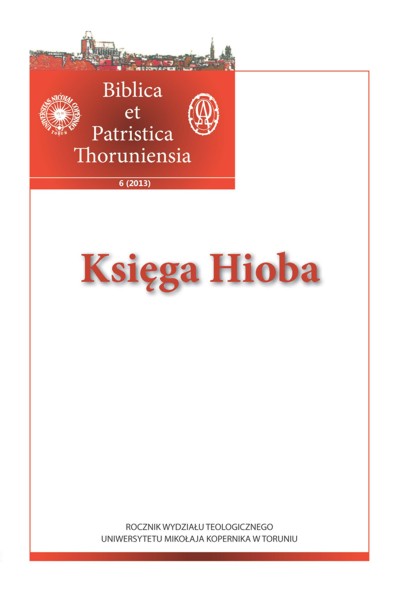„Uczyńmy człowieka na Nasz obraz i podobieństwo” (Rdz 1,26) w nauczaniu Jana Kasjana na temat modlitwy
DOI:
https://doi.org/10.12775/BPTh.2013.015Parole chiave
Jan Kasjan, monastycyzm, egzegeza literalna, doskonała modlitwa, kontemplacja, obraz Boga, antropomorfizmAbstract
Jan Kasjan, wielki mistrz życia monastycznego, przedstawiał w swoich pismach osiągnięcie Królestwa Bożego jako główny cel życia monastycznego, które poprzez doskonałą modlitwę daje przedsmak chwały przyszłego życia. Ten punkt widzenia jest podstawowy dla myśli Jana Kasjana, zwłaszcza w odniesieniu do modlitwy, która nie tylko pozwala mnichowi na rozmowę z Bogiem, ale daje też możliwość posmakowania rzeczywistości niebieskich. Odnajdujemy ten podstawowy punkt widzenia w większości pism Jana Kasjana. W jego czasach modlitwa była zasadniczo oparta na tekstach biblijnych, poprawna interpretacja Biblii w znaczący sposób mogła więc pomóc lub przeszkodzić mnichowi w kontemplacji i wzroście duchowym. Jan Kasjan przywołuje przykład błędnej interpretacji fragmentu Rdz 1,26, który odczytany w sposób literalny doprowadził wśród mnichów z pustyni egipskiej do herezji antropomorfizmu, która była jedną z przyczyn schyłku monastycyzmu na początku V wieku. Kasjan pragnie więc jako mistrz duchowy pomóc mnichom we właściwym podejściu do Pisma Świętego, zaznaczając od razu, że prawdziwą wiedzę (theoria) o Piśmie uzyskuje się nie poprzez zdolności intelektualne, ale raczej poprzez życie ascezy i nieustannej modlitwy (meditatio), które poprzez łaskę Bożą pozwalają mnichowi na odkrycie „głębszego znaczenia”.W odniesieniu do wersetu Rdz 1,26 Kasjan nie tylko uznał interpretację antropomorficzną za heretycką, ale podkreślił też, że doskonała modlitwa uwzględnia przejście od obrazu ziemskiego Chrystusa (przed zmartwychwstaniem) do Chrystusa przemienionego i ubóstwionego, którego widzimy już nie ludzkimi oczyma, lecz oczyma serca. Innymi słowy, doskonała modlitwa w celu doświadczenia miłości Boga, która jest miłością między Ojcem i Synem, musi koniecznie odrzucić wszelki obraz Boga. To żywienie się miłością prowadzi nas coraz bliżej do prawdziwego obrazu i podobieństwa Boga.
Riferimenti bibliografici
Apoftegmaty Ojców Pustyni, t. 1, Gerontikon. Księga starców (przeł. M. Borkowska), red. M. Starowieyski (= Źródła Monastyczne 4), Kraków 20042.
Codina V., El aspecto cristologico en la espiritualidad de Juan Casiano, „Orientalia Christiana Analecta” 17, Rome 1966.
Desprez V., Początki monastycyzmu (przeł. J. Dembska), t. 1 (= Źródła Monastyczne 21), Kraków 1999.
Desprez V., Początki monastycyzmu (przeł. J. Dembska), t. 2 (= Źródła Monastyczne 22), Kraków 1999.
Evagre le Pontique, Traité pratique ou Le moine, (red. A. e C. Guillaumont), S.C. 170–171, Paris 1971.
Evdokimov P., La femme et le salut du monde: étude d’anthropologie chrétienne sur les charismes de la femme, Tournai–Paris 1958.
Jan Kasjan, Rozmowy z Ojcami (przeł. A. Nocoń), „Źródła Monastyczne” n. 28, Kraków 2002 (Rozmowy I–X).
Jan Kasjan, Rozmowy z Ojcami „Pisma Ojców Kościoła” n. 7 (przeł. L. Wrzoł), Poznań 1929 (Rozmowy XI–XXIV).
Kanior M., Historia monastycyzmu chrześcijańskiego, t. 1, Kraków 1993.
Lari O., Giovanni Cassiano. Conferenze spirituali, t. 1, Roma 1965.
Leloup J. Y., Hezychazm – zapomniana tradycja modlitewna (przeł. H. Sobieraj), Kraków 1996.
Starowieyski M., Czego mogą nas nauczyć Ojcowie Pustyni (= Listowa biblioteka 18), Kraków 2006.
Starowieyski M., Początki monastycyzmu zachodniego, „Warszawskie Studia Teologiczne” 1 (1983), 258–283.
Stewart C., Kasjan Mnich (przeł. T. Lubowiecka), (= Źródła Monastyczne 34), Kraków 2004.
Downloads
Pubblicato
Come citare
Fascicolo
Sezione
Licenza
CC BY ND 4.0. Posiadaczem prawa autorskiego (Licencjodawcą) jest Autor, który na mocy umowy licencyjnej udziela nieodpłatnie prawa do eksploatacji dzieła na polach wskazanych w umowie.
- Licencjodawca udziela Licencjobiorcy licencji niewyłącznej na korzystanie z Utworu/przedmiotu prawa pokrewnego w następujących polach eksploatacji: a) utrwalanie Utworu/przedmiotu prawa pokrewnego; b) reprodukowanie (zwielokrotnienie) Utworu/przedmiotu prawa pokrewnego drukiem i techniką cyfrową (e-book, audiobook); c) wprowadzania do obrotu egzemplarzy zwielokrotnionego Utworu/przedmiotu prawa pokrewnego; d) wprowadzenie Utworu/przedmiotu prawa pokrewnego do pamięci komputera; e) rozpowszechnianie utworu w wersji elektronicznej w formule open access na licencji Creative Commons (CC BY-ND 3.0) poprzez platformę cyfrową Wydawnictwa Naukowego UMK oraz repozytorium UMK.
- Korzystanie przez Licencjobiorcę z utrwalonego Utworu ww. polach nie jest ograniczone czasowo ilościowo i terytorialnie.
- Licencjodawca udziela Licencjobiorcy licencji do Utworu/przedmiotu prawa pokrewnego nieodpłatnie na czas nieokreślony
PEŁEN TEKST UMOWY LICENCYJNEJ >>
Stats
Number of views and downloads: 702
Number of citations: 0



